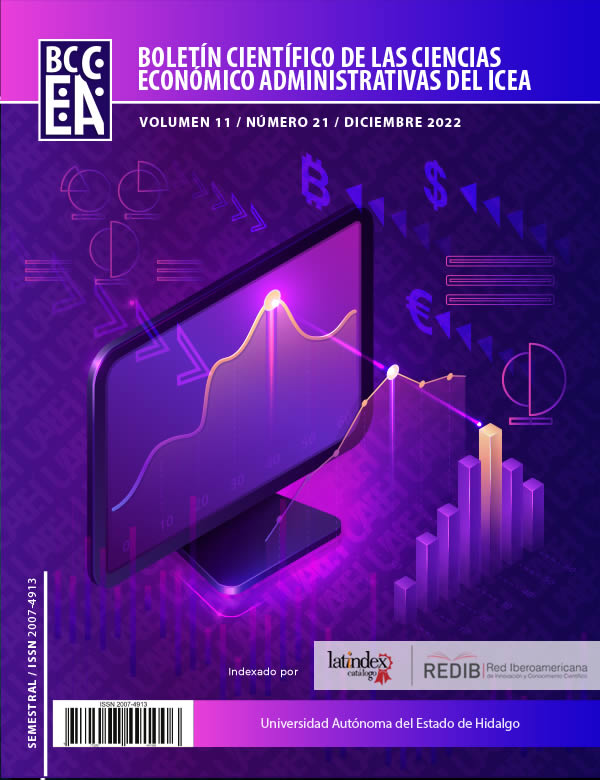Tourism as Cultural Heritage – Identity and Development Customs and Traditions in the State of Hidalgo, Mexico the Day of the Dead and the tourist – cultural experience
DOI:
https://doi.org/10.29057/icea.v11i21.9472Keywords:
Tourism, culture, traditionAbstract
The tangible or intangible cultural heritage of tourist destinations provides this opportunity, as it allows the traveller to come into contact with the culture of the other and be a protagonist of it, resulting in a greater interaction of tourists, in this sense, this document takes as a case study the celebration of the Day of the Dead in the region known in the State of Hidalgo, Mexico, due to its geocultural delimitation, as the Huasteca, with the objective of delimiting the existing relationship between tourism and culture in addition to demonstrating the elements that are considered necessary to generate the development of tourism in this geographical area with the aim of maximising the benefits for the local community.
Downloads
Publication Facts
Reviewer profiles N/A
Author statements
Indexed in
- Academic society
- N/A
References
Bonink, C. & Richards, G. (1992). Cultural Tourism in Europe. London, University of North London.
Giddens, A. (2011). La constitución de la sociedad, bases para la teoría de la estructuración, Amorrortu Edit. Spain.
Durkheim, E. (2001). Las reglas del Método Sociológico, FCE, México.
Geertz, C. (2003). The interpretation of cultures Gedisa Edit. Barcelona Spain.
Croes, R. & Vanegas, M. (2008). Cointegration and Causality between Tourism and Poverty Reduction. Journal of Travel Research. 47 (1), 94-103.
López, P. & Palomino, V. (2008). El turismo como actividad emergente para las comunidades y pueblos indígenas. Turismo, identidades y exclusión México: UAM: Casa Juan Pablos, (31-50).
Faber, B. & Gaubert, C. (2019). Tourism and Economic Development: Evidence from Mexico’s Coastline, American Economic Review (36) 42- 60.
Averis, D. (2016). Economics Key Ideas Textbook. Bowden: Essentials Education.
Rivera, R. & Peralta, A. (2016). Turismo Cultural en México, Reporte Anáhuac de Investigación Turística 1 (4) 4 – 14.
UNESCO (2008) Las fiestas indígenas dedicadas a los muertos, lista Representativa del Patrimonio Cultural Inmaterial de la Humanidad.
Richards, G. y Munster, W. (2010). Developments and Perspectives in Cultural Tourism Research – Cultural Tourism Research Methods.
Mallor, E., González, M. & Fayos, T. (2013). ¿Qué es y cómo se mide el Turismo Cultural? Un estudio longitudinal con series temporales para el caso Español, PASOS Revista de Turismo y Patrimonio Cultural 11, 269 – 284.
Watson, G. & Kopachevsky, J. (1996). Interpretations of tourism as commodity. In Y. Apostolopoulos, Leivadi, S. & Yiannakis, A. (eds.). The sociology of tourism: Theoretical and empirical investigations, pp. 281- 300.
García, N. (1999). Los usos sociales del patrimonio Cultural. En E. Aguilar Criado, Patrimonio Etnológico. Nuevas perspectivas de Andalucía: Consejería de Cultura. Junta de Andalucía.
Sharpley, R. (2018). Tourism, tourists and society, 5th ed. Abingdon: Routledge.
Bourdieu, P. (2010). El sentido social del gusto. Madrid: Siglo veintiuno editores.
Dolezal, C. (2015). The tourism encounter in community-based tourism in Northern Thailand: Empty meeting ground or space for change? ASEAS – Austrian Journal of South East Asian Studies, 8(2), 165-186.
Arévalo, J. (2012). El patrimonio como representación colectiva: la intangibilidad de los bienes culturales. Andes, 23(2), 00.
Quinn, N. (2005). Finding Culture in Talk: A Collection of Method. Culture Mind and Society. The Book Series of the Society for Psychological Anthropology. USA: Palgrave.
Hiriart, C. (2008). La festividad de noche de Muertos en Michoacán, México ¿Un patrimonio inmaterial en riesgo? Boletín Gestión Cultural, 17.
Alegre L. (2004). El camino de los muertos: Relaciones intratextuales en los ritos nahuas de Velación de Cruz y Xantolo. Opción, 20(44),9-27.
Martínez, A. (2020). Reciprocidades corporales: prestar el cuerpo a los muertos en una comunidad nahua de la Huasteca hidalguense. Cuicuilco. Revista de ciencias antropológicas, 27(78), 77-96.
Pulido, J., Casado, J. & Carrillo, I. (2019). Introducing olive-oil tourism as a special interest tourism, Heliyon 5 1- 8.
Cohen, E. (1988). Authenticity and commoditization in tourism. Annals of Tourism Research, 15(3), 371–386.
Cánovas, E. (2016). The correspondence between building authentic experiences and heritage interpretation. Reflections from the existential authenticity, PASOS Revista de Turismo y Patrimonio Cultural, 14 (2).
Scheyvens, R. (2002). Tourism for development: Empowering communities. Harlow: Pearson Education Ltd.
Velázquez, M. & Soto E. (2020). La cultura como política pública para el desarrollo de las comunidades indígenas en el estado de Hidalgo,México. Retos y avances Estudios sobre las Culturas Contemporáneas, vol. XXV, núm. 50.
Maoz, D. (2006). The mutual gaze. Annals of Tourism Research, 33(1), 221-239.



















